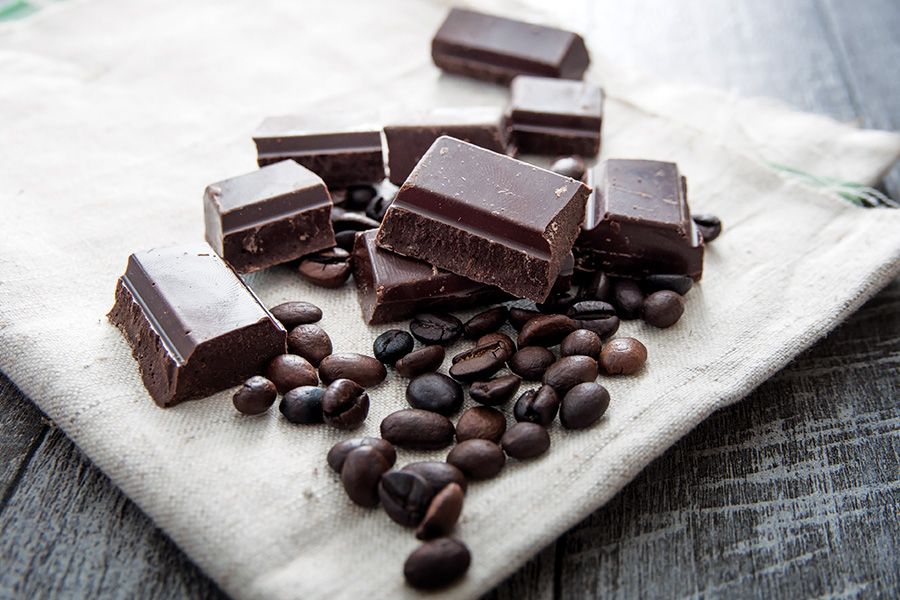Millions of people around the world rely on their daily cup of coffee to kickstart the morning. And for good reason. Caffeine is known to stimulate the brain and central nervous system, support heart rate and breathing, and provide a welcome boost in mental energy and alertness.
But coffee isn’t the only treat people turn to for comfort or a pick-me-up. Chocolate, especially personalized chocolate bars, is beloved across the globe in all its rich and decadent forms. So, what’s the link between caffeine and chocolate? More specifically, does chocolate contain caffeine?
Keep reading to discover how much caffeine is in chocolate, where it comes from, and a few surprising facts you may not know.
- The benefits of caffeine and chocolate
- The production and structure of chocolate
- The science behind chocolate and caffeine
- How much caffeine is in chocolate?
- How much caffeine is in dark chocolate?
- Does milk chocolate contain caffeine?
- Is there caffeine in white chocolate?
- Q: What are the benefits of caffeine?
- Q: Does all chocolate contain caffeine?
- Q: Does chocolate naturally contain caffeine?
- Q: How does the caffeine in chocolate compare to coffee?
- Q: Can sensitive individuals consume chocolate?
- Q: What factors influence the caffeine content in chocolate?
- Q: Can theobromine and caffeine have side effects?
- The bottom line
- Looking for a sweet and unique gift idea? Look no further!
The benefits of caffeine and chocolate
Although coffee is a major source of caffeine, caffeine can be found in multiple other sources such as in soft drinks, teas, and other beverages.
Apart from decreasing tiredness and acting as a mild diuretic, caffeine is sometimes also used to treat migraines and tension headaches.
As for chocolate, those who have had the pleasure to consume it at some point in time will know that apart from its delicious flavor, it also provides an energy or mood boost.
Darker chocolate has also been said to be good for the heart and it contains antioxidants, which are good for one’s physical well-being.

The production and structure of chocolate
Interestingly enough, chocolate is made from the seeds of the fruit in cacao trees – cocoa beans. Trees are usually found in the equatorial regions of the world and you may get cocoa beans from places such as Mexico to Ecuador and Uganda to Ghana, among many others.
In terms of the production process, the shells of the cocoa beans are first removed. Then, what’s left over is fermented, dried, and liquefied in the chocolate-making process resulting in cocoa butter and cocoa solids.
It must be mentioned at this point that the higher the cocoa content, the darker the chocolate and the healthier it is for consumption. However, chocolate that is commercially prepared may also contain other added ingredients such as sugar, cocoa butter, vanilla, and lecithin.
We should also mention that although cocoa solids do contain caffeine, cocoa butter doesn’t.
Caffeine content varies by country
Did you know that where cacao is grown can affect how much caffeine ends up in your chocolate? Factors like climate, soil, and altitude all play a role in shaping the makeup of cacao beans, including their caffeine levels.
A large-scale study analyzing 200 cacao samples from 26 countries found some interesting patterns:
- Cacao from the Caribbean and South America tends to be much higher in caffeine than beans grown in Africa.
- Top caffeine levels were found in cacao from Ecuador, Venezuela, and Peru.
- Lower caffeine levels showed up in cacao from Ghana, Ivory Coast, and Mexico.
Here’s a quick comparison of how much caffeine you’ll find in 75% dark chocolate from different countries:
- Ecuador: 42 mg per 1 oz
- Peru: 41 mg per 1 oz
- Mexico: 18 mg per 1 oz
So next time you’re choosing a chocolate bar, keep in mind that the country of origin can make a big difference; not just in flavor, but in the energy kick, too!
The science behind chocolate and caffeine
The cocoa bean or cocoa solid has three naturally-occurring stimulants. These are
- Theobromine
- Caffeine, and
- Theophylline
What’s interesting about these three stimulants is that they all belong to the same family or class of alkaloids that are called xanthines.
In nature, xanthines are used to protect plants and trees from insects. But when used in the right dosage by humans, they can help improve our cognitive function, protect us from tooth decay, reduce risks of Alzheimer’s and cardiovascular disease, and overall, they act as a nice pick-me-up when energy levels are low.
With all this in mind, you may have come to the conclusion that all chocolate contains caffeine. But the real answer is that this level of caffeine will greatly vary from country to country in which the cacao trees are raised.
For example, research done on theobromine content in cocoa to determine cocoa solids content in chocolate found that cocoa grown in South American countries has a significantly higher level of caffeine than African cacao.
To further complicate things, it also matters when exactly the cacao is harvested and roasted. Studies have shown that harvesting cacao in the dry season has a much higher caffeine yield than cacao harvested in wet or rainy seasons.
And on top of all this, the roasting process plays little to no role in the caffeine content found in chocolate.
How much caffeine is in chocolate?
Now that we’ve got the basics out of the way, you may have questions such as how much caffeine is in chocolate and whether the type of chocolate affects the caffeine content. Spoiler alert: yes, it does! However, let’s take a deeper dive into the mechanics behind it, starting with dark chocolate.
We all know that dark chocolate has several health benefits and you’re more likely to get a boost of energy by consuming this chocolate type than any other.
In addition, as opposed to drinking a cup of coffee, consuming a piece or two of dark chocolate means you’re much less likely to experience the “dip” effect of chocolate or the associated “crash” or “jitters”.
It’s also likely you’ll sleep better at night although for those sensitive to caffeine, this is not recommended.
And as for the other chocolate types, the lighter in color they are, the less cacao solids or cacao content in them and therefore the less caffeine.
How much caffeine is in dark chocolate?
We’ll start with dark chocolate, which contains 12 mg of caffeine per ounce. Said differently, dark chocolate with 70% to 85% cacao solids has 22.7 mg of caffeine, while dark chocolate with 45% to 59% cacao solids contains 12.2 mg of caffeine.
Does milk chocolate contain caffeine?
Semi-sweet chocolate and candies contain around 17.6 mg of caffeine. Milk chocolate, on the other hand, contains around 9 mg of caffeine per 1.55 ounces. Put in a different way, the average milk chocolate bar will contain 5.6 mg of caffeine.
Is there caffeine in white chocolate?
As for white chocolate, you’ll be interested to know, it contains zero caffeine because it does not contain cocoa solids but is mostly made up of cocoa butter.
FAQ About Chocolate and Caffeine
Q: What are the benefits of caffeine?
A: Caffeine is a natural stimulant that offers several well-known benefits when consumed in moderation. Some of the benefits of caffeine include that it can help improve alertness, boost concentration, and reduce feelings of fatigue by stimulating the brain and central nervous system. Caffeine may also enhance physical performance, support short-term memory, and elevate mood. That’s why it’s commonly found in coffee, tea, and even small amounts in chocolate.
Q: Does all chocolate contain caffeine?
A: No. While dark and milk chocolates contain varying amounts of caffeine, white chocolate has none because it lacks cocoa solids.
Q: Does chocolate naturally contain caffeine?
A: Yes, chocolate contains caffeine naturally because it comes from cocoa beans, which have small amounts of caffeine in them. Unlike sugar or milk powder, caffeine isn’t added during production. It’s already present in the cocoa solids used to make chocolate.
Q: How does the caffeine in chocolate compare to coffee?
A: A single serving of chocolate contains significantly less caffeine than a cup of coffee. For example, a cup of coffee has about three times the caffeine as dark chocolate.
Q: Can sensitive individuals consume chocolate?
A: Yes, but it depends on the type. Milk chocolate has a lower caffeine content, and white chocolate contains no caffeine at all.
Q: What factors influence the caffeine content in chocolate?
A: Factors like the country of origin, harvesting season, and cocoa content significantly impact caffeine levels in chocolate.
Q: Can theobromine and caffeine have side effects?
A: Theobromine (along with caffeine) usually isn’t harmful to humans when consumed in moderate amounts. In fact, it can give your mood a bit of a boost. But too much, especially more than 250 milligrams, can lead to restlessness or even the opposite of a feel-good high. Since both theobromine and caffeine are stimulants, people who are sensitive to caffeine might find that a piece of dark chocolate or a mug of hot cocoa at night keeps them tossing and turning. So, if you’re caffeine-sensitive, maybe save the chocolatey treats for earlier in the day.
The bottom line
If you are sensitive to caffeine and you still consume coffee but you love chocolate, you don’t have to worry just yet.
That’s because the amount of stimulant found in chocolate can be compared to around one cup of coffee, which has about three times as much caffeine as chocolate.
The roasting methods, the processing of the cocoa beans, the country of origin, the climate, and season of harvesting will all play a major role in how much caffeine is found in chocolate.
But for now, you can rest assured that your caffeine intake from chocolate is much lower than your caffeine intake from coffee or other caffeinated beverages and soft drinks.
Looking for a sweet and unique gift idea? Look no further!
Discover our wide range of personalized chocolate and custom candy bars, all of which can be customized with your own special message or design. Don’t miss out on the chance to create a truly one-of-a-kind gift – check out our selection today!

